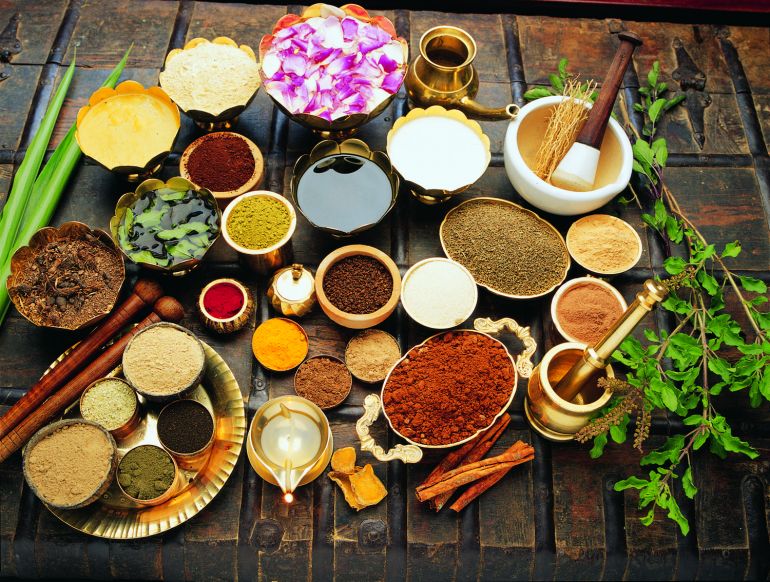Dr. Sonia Verma
BAMS, M.Sc (Yoga therapy)
PGDYT, UGC-NET (Yoga),
QCI (level1&2) & PhD (pursuing)
Abstract: Ayurveda is the science of life and living. Ayurveda has given some dietary plans to protect the health of an individual. The food can provide several benefits to our physical, mental and spiritual health, if we follow the disciplines laid down by our rishis and ancient scriptures of Ayurveda. The present paper discusses the basic principles of diet based on Ayurveda and is helpful in maintaining better health for all.

Introduction: Ayurveda is a system of medicine, and the primary aim of an Ayurvedic diet is promotion, preservation and restoration of health, including spiritual health (Bijlani, 2012). According to Acharya Charaka, the purpose of Ayurveda is:
स्वस्थस्य स्वास्थ्य रक्षणं आतुरस्य विकारप्रशमनं च ।।
(चरक संहिता सूत्र ३०/२६)
‘Swasthasyaswasthyarakshanamaturasyavikarprashmanamch’
It means that the main aim of ayurveda is to protect the health of the healthy individual and to alleviate the imbalance or disease of unhealthy individual.
 Ahara, Nidra, Brahamacharya are the three sub-pillars (Upstambhas) of good health that are mentioned in Charaka Samhita. These upstambhas support the body. Ahara has been considered as the best medicine and given extra importance among all the three sub-pillars. But, the concept of Ahar itself is very comprehensive in Ayurveda. As per the Ayurvedic texts, Ahara is any substancethat is swallowed through throat; hence Aushadha can be considered as Ahara and ahara as aushadha. The frequency and amount of ahara for each individual depends on the status of agnibala of the individual. The diet is one of the most important indicators of health of a person. In Charaka Samhita, it is mentioned that the amount of food digested in the appropriate time is the quantity of food for the individual. Due to increase in competition level in various fields, one doesn’t get time to eat properly and at appropriate time. No preference is given on the dietary habits like when to eat, what to eat, how to eat, which may cause many diseases. In Ayuvedic texts, several laws of dos and don’ts are mentioned which help to prevent and/or cure many diseases.
Ahara, Nidra, Brahamacharya are the three sub-pillars (Upstambhas) of good health that are mentioned in Charaka Samhita. These upstambhas support the body. Ahara has been considered as the best medicine and given extra importance among all the three sub-pillars. But, the concept of Ahar itself is very comprehensive in Ayurveda. As per the Ayurvedic texts, Ahara is any substancethat is swallowed through throat; hence Aushadha can be considered as Ahara and ahara as aushadha. The frequency and amount of ahara for each individual depends on the status of agnibala of the individual. The diet is one of the most important indicators of health of a person. In Charaka Samhita, it is mentioned that the amount of food digested in the appropriate time is the quantity of food for the individual. Due to increase in competition level in various fields, one doesn’t get time to eat properly and at appropriate time. No preference is given on the dietary habits like when to eat, what to eat, how to eat, which may cause many diseases. In Ayuvedic texts, several laws of dos and don’ts are mentioned which help to prevent and/or cure many diseases.
Basic Principles of Diet and their Implications: There are eight basic rules in regard to diet also known as “AshtaAhara Vidhi Visheshayatan”, mentioned in ‘Charaka Vimana Sthana’ Each rule mentioned in Ahara-Vidhi Vidhana has a functional logic and helps to maintain the health.
These eight principles are (अष्टाहार विधिविशेषायतन): Prakriti, Karana, Samyog, Rashi, Desha, Kala, Upyog-Samstha and Upyokta
- Prakriti(प्रकृति)– It is also known as the natural quality of the food. Every food has its own prakriti or swabhava like guru (heaviness), laghu (lightness) etc
Eg. Meat is heavy whereas vegetables are light to digest.
- Karana(करण)– It is known as the processing or transformation of qualities of food; e.g., Steamed or roasted food is light as compare to fried food; curd made from milk provocateskapha dosha but butter milk balances all the three doshas, made from same milk.
- Samyoga(सम्योग)– Mixture or combination of two or more substances is known as samyoga. The combination can be beneficial and it can be dangerous also.e.g. the quality of milk and alcohol are totally opposite and this combination can harm the body; but the combination of milk and turmeric is extremely beneficial for the health and when black pepper is added to this turmeric milk it enhances the properties of turmeric and increases its absorption
- Rashi (राशि)-It means quantity of food. Quantity of food intake is important for keeping the body disease free. The amount of food intake is different for every person. Proper quantity of ideal food should be consumed. Two types of rashi are mentioned in the text i.e.,sarvagraharashi and parigraharashi.
- Sarvagraharashi(सर्वग्रह राशि)- It means all the ingredients and inclusions of diet to be served in totality. Eg. chapati, vegetable, curd, sweet dish etc all to be served in small quantity which makes it balanced diet.
- Parigraharashi(परिग्रह राशि)- It means ingredients and inclusions of food are taken separately. Eg- chapati, rice, dal (pulses), vegetable, sweet dish is served in a plate but if only the sweet dish is consumed by an individual which makes the diet unbalanced and hence causes illness.
- Desha(देश) – It covers the place. It means the food one eats comes from which place and how it has been grown and cultivated. These all things are to be considered as it affects the quality of food; e.g. The herbs grown in Himalayas are more potent than the herbs grown in dry regions. There are three places-
- Jaangal(जांगल)- desert region or dry region. It is vata predominated place
- Anupa(अनूप)– marshy region. It is kapha predominated
- Sadharandesha(साधारण देश) – moderate region
The body of individual is adapted to the particular food available at particular region. This is also known as satmya (सात्म्य). The people who live in the particular region become satmya to Ahaar and Vihar of that region and hence they are not vulnerable to the diseases of the particular area. But during travelling many people suffer from sickness and get disease very easily this is due to Desha-parivartana. When their desha is changed they consume the food of changed desha. Their whole physiology gets disturbed and hence persons suffer from many diseases.
- Kala(काल) – It means time of consumption of food. It can be divided into three categories:
- The person who consumes food at particular time and is punctual about the timings of intake of food will be healthier as compare to one who is not punctual for the consumption of food.
- In some cases, people follow their hunger and take food when they feel hungry. These people are also healthy.
- Whereas in some cases people do not follow their hunger and time of consumption of food. These people suffer from various illnesses in long run.
- Upyogasamstha (उपयोग संस्था)– It is known as the rules for consuming food i.eaharvidhividhan. Acharya Charak has given special dietary rules which should be followed by an individual.
The rules are:
- Intake of food at in time (काल भोजनम्).
- Food intake as per suitability (सात्म्य भोजन)
- Food intake as per the prakriti of individual (हित भोजन)
- Proper hygiene (शुचि भोजन)
- Intake of food which is unctuous (स्निग्ध भोजन)
- Intake of food which is warm (उषण भोजन)
- Intake of food which is easy to digest (लघु भोजन)
- Eat while there is in interest to food and while eating concentrate on food and the process of eating (तन मनः भोजन)
- Eat food with six taste components (षडरसयुक्त भोजन)
- Food should be primarily sweet in nature (मधुरपर्याय)
- Food should be ingested calmly, neither too slow nor too fast (न अतिद्रुत विलंबिता)
- After bathing (स्नातः)
- Food intake only when there is sufficient hunger(क्षुधवन)
- Proper washing of hand, feet and face should be done before food intake (धौतपादकरआननः)
- After offering prayers and paying obeisance to gods and forefathers (पित्रदेवतर्पण)
- After offering food to guests, teachers and children (अथिति बालकगुरु तर्पण)
- Without disgracing food (अनिन्दन भुन्जान)
- Silently (मौन)
- Upyokta(उपयोक्ता)– It means the person who consumes the food. Consumer is very important as he is responsible for the habitual intake of food which is also known as ‘Oksatmya’; e.g., people living near the coastal regions are habitual of taking sea food daily but it is difficult for the people living in the plains to digest the sea-food daily.
CONCLUSION:
Mahatma Gandhi said, ‘one should not eat in order to please the palate, but just to keep the body going. When each organ of sense subserves the body, and through the body the soul, its special relish disappears and then alone does it begin to function in the way nature intended it to’. This profound statement is the gist of Ayurvedic wisdom of food contained the basic principles of diet outlined above. An individual can increase his/her immunity, can strengthen the life-force and increase longevity, by following the above said dietary principles in true spirit.
REFERENCES:
- Maharshi Charak: Charak Samhita: Publications, Jaipur.
- Bijlani, R (2012): Eating Wisely and Well, Rupa Publications, New Delhi.





